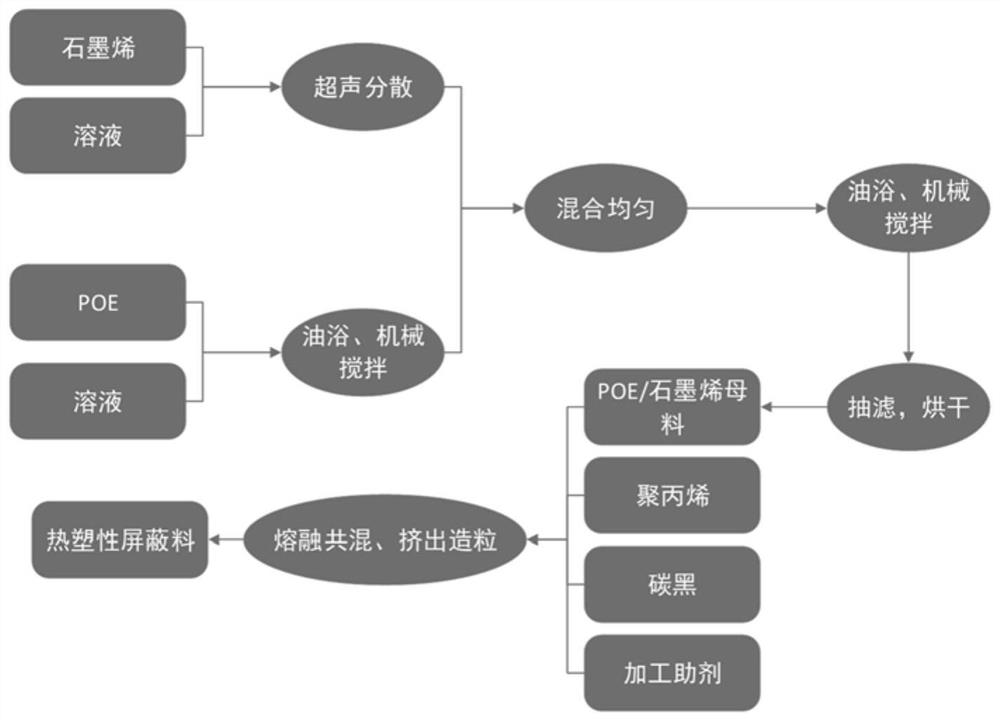Graphene-doped polypropylene-based thermoplastic cable shielding material and preparation method thereof
A technology of thermoplastic and shielding materials, which is applied in the field of semi-conductive shielding materials and preparation of graphene-doped thermoplastic cables, which can solve the problems of thermal stability, non-compliance with green development strategy, and inability to recycle.
- Summary
- Abstract
- Description
- Claims
- Application Information
AI Technical Summary
Problems solved by technology
Method used
Image
Examples
preparation example Construction
[0037] see figure 1 , the preparation method of the shielding material for the above-mentioned polypropylene-based thermoplastic cable, comprising the following steps:
[0038] 1) Add polyethylene octene co-elastomer (POE) into the solvent, control the mass ratio of POE to solvent at 1:10~30, heat the oil bath to 100~120°C, keep mechanical stirring for 1-2h, and obtain POE solution ;
[0039] 2) Add graphene powder into the solvent, the mass ratio of graphene to solvent is 1:1000-2000, ultrasonically vibrate for 10-30min, and the ultrasonic power is 150w-300w, and obtain the graphene slurry after ultrasonic dispersion;
[0040] 3) Add the graphene slurry into the POE solution, maintain an oil bath at 100-120°C, and mechanically stir for 5-7 hours to obtain a uniformly mixed POE / graphene mixture;
[0041] 4) Add the POE / graphene mixture into the Buchner funnel, vacuum filter to obtain the flocculent mixture, put the obtained mixture into a vacuum oven, treat at 40-60°C for 24...
Embodiment 1
[0047] A shielding material for polypropylene-based thermoplastic cables doped with graphene, in parts by mass, comprising:
[0048] Polypropylene: 70 parts
[0049] Polyethylene octene co-elastomer (POE): 30 parts
[0050] Conductive carbon black: 14 parts
[0051] Graphene: 1 part
[0052] Coupling agent A172: 1 part
[0053] Antioxidant 300: 1.5 parts
[0054] Add 30 parts of POE to 600 parts of toluene, heat the oil bath to 100°C, and mechanically stir for 1 hour to form a POE solution. Add 1 part of graphene with a layer number of 3 to 500 parts of toluene, ultrasonically disperse for 15 minutes, and ultrasonic power is 250w , to make a graphene dispersion, add the graphene dispersion to the POE solution, keep the oil bath heating at 100 ° C and mechanically stir for 6 hours to obtain a POE / graphene mixture, and obtain a flocculent POE / graphene mixture after vacuum filtration , put the mixture in a vacuum oven, and dry the solution at 50°C for 24 hours to obtain a PO...
Embodiment 2
[0056] A shielding material for polypropylene-based thermoplastic cables doped with graphene, in parts by mass, comprising:
[0057] Polypropylene: 60 parts
[0058] Polyethylene octene co-elastomer (POE): 40 parts
[0059] Conductive carbon black: 14 parts
[0060] Graphene: 1 part
[0061] Coupling agent kh550: 1 part
[0062] Antioxidant 1010: 1 part
[0063] Antioxidant 300: 0.5 parts
[0064] Add 40 parts of POE to 600 parts of xylene, heat the oil bath to 120°C, and mechanically stir for 1 hour to form a POE solution. Add 1 part of graphene to 600 parts of toluene, ultrasonically disperse for 10 minutes, and ultrasonic power is 300w to make graphite Add the graphene dispersion with 3 layers to the POE solution, keep the oil bath heating at 120°C and mechanically stir for 8 hours to obtain the elastomer / graphene mixture, and obtain the flocculent POE / graphite after vacuum filtration Graphene mixture, put the mixture in a vacuum oven, treat at 50°C for 24h, and dry t...
PUM
 Login to View More
Login to View More Abstract
Description
Claims
Application Information
 Login to View More
Login to View More - R&D
- Intellectual Property
- Life Sciences
- Materials
- Tech Scout
- Unparalleled Data Quality
- Higher Quality Content
- 60% Fewer Hallucinations
Browse by: Latest US Patents, China's latest patents, Technical Efficacy Thesaurus, Application Domain, Technology Topic, Popular Technical Reports.
© 2025 PatSnap. All rights reserved.Legal|Privacy policy|Modern Slavery Act Transparency Statement|Sitemap|About US| Contact US: help@patsnap.com



